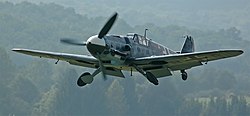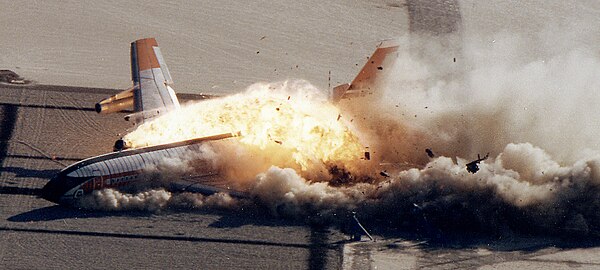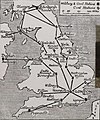Portal:Aviation
| Main page | Categories & Main topics |
|
Tasks and Projects |
The Aviation Portal

Aviation includes the activities surrounding mechanical flight and the aircraft industry. Aircraft includes fixed-wing and rotary-wing types, morphable wings, wing-less lifting bodies, as well as lighter-than-air aircraft such as hot air balloons and airships.
Aviation began in the 18th century with the development of the hot air balloon, an apparatus capable of atmospheric displacement through buoyancy. Clément Ader built the "Ader Éole" in France and made an uncontrolled, powered hop in 1890. This is the first powered aircraft, although it did not achieve controlled flight. Some of the most significant advancements in aviation technology came with the controlled gliding flying of Otto Lilienthal in 1896; then a large step in significance came with the construction of the first powered airplane by the Wright brothers in the early 1900s. Since that time, aviation has been technologically revolutionized by the introduction of the jet which permitted a major form of transport throughout the world. (Full article...)
Selected article
Arkia was founded in 1949 as Israel Inland Airlines when it became clear that there was demand for a local airline to connect the north of Israel (especially Tel Aviv) with the southern region of the Negev, as a subsidiary of El Al, Israel's national airline. Flights starting the following year with the airline unsing De Havilland DH.89 aircraft, followed by Douglas DC-3s, to connect Rosh Pina in the north to the port of Eilat in the south. El Al held a 50% stake in the airline at this time with Histadrut, Israel's labour federation, being the other shareholder. The airline later evolved to become Eilata Airlines, Aviron, and then to Arkia Israel Airlines. In its first year of service, Israel Inland carried 13,485 passengers on their twice weekly flight, operated by a Curtis Commando. (Full article...)
Selected image
Did you know
...that in the late 1940s the USAF Northrop YB-49 set both an unofficial endurance record and a transcontinental speed record? ..that Elm Farm Ollie in 1930 became the first cow to be milked while flying in an airplane? ... that Wing Commander John Lerew, ordered to defend Rabaul against Japanese invasion in 1942, signaled headquarters the legendary gladiatorial phrase "We who are about to die salute you"?
General images -
In the news
- May 29: Austrian Airlines cancels Moscow-bound flight after Russia refuses a reroute outside Belarusian airspace
- August 8: Passenger flight crashes upon landing at Calicut airport in India
- June 4: Power firm helicopter strikes cables, crashes near Fairfield, California
- January 29: Former basketball player Kobe Bryant dies in helicopter crash, aged 41
- January 13: Iran admits downing Ukrainian jet, cites 'human error'
- January 10: Fire erupts in parking structure at Sola Airport, Norway
- October 27: US announces restrictions on flying to Cuba
- October 3: World War II era plane crashes in Connecticut, US, killing at least seven
- September 10: Nevada prop plane crash near Las Vegas leaves two dead, three injured
- August 6: French inventor Franky Zapata successfully crosses English Channel on jet-powered hoverboard
Related portals
Associated Wikimedia
The following Wikimedia Foundation sister projects provide more on this subject:
-
Commons
Free media repository -
Wikibooks
Free textbooks and manuals -
Wikidata
Free knowledge base -
Wikinews
Free-content news -
Wikiquote
Collection of quotations -
Wikisource
Free-content library -
Wikiversity
Free learning tools -
Wikivoyage
Free travel guide -
Wiktionary
Dictionary and thesaurus
Selected biography
Selected Aircraft

The Messerschmitt Bf 109 was a German World War II fighter aircraft designed by Willy Messerschmitt in the early 1930s. It was one of the first true modern fighters of the era, including such features as an all-metal monocoque construction, a closed canopy, and retractable landing gear. The Bf 109 was produced in greater quantities than any other fighter aircraft in history, with a total of 33,984 units produced up to April 1945. Fighter production totalled 47% of all German aircraft production, and the Bf 109 accounted for 57% of all German fighter types produced.
The Bf 109 was the backbone of the Luftwaffe fighter force in World War II, although it began to be partially replaced by the Focke-Wulf Fw 190 from 1941. The Bf 109 was the most successful fighter of World War II, shooting down more aircraft than any of its contemporaries. Originally conceived as an interceptor, it was later developed to fulfill multiple tasks, serving as bomber escort, fighter bomber, day-, night- all-weather fighter, bomber destroyer, ground-attack aircraft, and as reconnaissance aircraft.
The Bf 109 was flown by the three top-scoring fighter aces of World War II: Erich Hartmann, the top scoring fighter pilot of all time with 352 victories, Gerhard Barkhorn with 301 victories, and Günther Rall with 275 victories. All of them flew with Jagdgeschwader 52, a unit which exclusively flew the Bf 109 and was credited with over 10,000 victories, chiefly on the Eastern Front. Hartmann chose to fly the Bf 109 in combat throughout the war, despite being offered the use of the Me 262. Hans-Joachim Marseille, the highest scoring German ace in the North African Campaign, also scored all of his 158 victories flying the Bf 109, against Western Allied pilots.
- Span: 9.925 m (32 ft 6 in)
- Length: 8.95 m (29 ft 7 in)
- Height: 2.60 m (8 ft 2 in)
- Engine: 1× Daimler-Benz DB 605A-1 liquid-cooled inverted V12, 1,475 PS (1,455 hp, 1,085 kW)
- Cruising Speed: 590 km/h (365 mph) at 6,000 m (19,680 ft)
- First Flight: 28 May 1935
Today in Aviation
- 2015 – TransAsia Airways Flight 235 strikes a viaduct and crashes into the Keelung River shortly after takeoff from Taipei Songshan Airport, killing 43 of the 58 people on board. The causes of the crash were a malfunction of the number two engine and the pilots shutting down the wrong engine.
- 2012 – Australian filmmaker Andrew Wight is at the controls of his private Robinson R44 helicopter with American filmmaker Mike deGruy as a passenger for a flight to scout filming locations when the helicopter crashes on takeoff and burns at Jaspers Brush near Berry in New South Wales, Australia. Both men are killed.[1]
- 2011 – First flight of the Northrop Grumman X-47B, an American demonstration Unmanned Combat Aerial Vehicle (UCAV).
- 2010 – Yakutia Airlines Flight 425, operated by Antonov An-24 RA-47360 suffered an engine failure on take-off from Yakutsk Airport for Olekminsk Airport. During the subsequent landing, the nose and port main undercarriage were retracted, causing substantial damage to the aircraft.[2]
- 2009 – N834TP, a Douglas Aero Modified Turbo DC-3 operated by the National Test Pilot School is involved in a take-off accident at Mojave Air & Space Port, United States, and substantially damaged.
- 2009 – C-FCCE, a DHC-6 Twin Otter 100 operated by Transwest Air, crashes on take-off from La Ronge (Barber Field) Airport, Canada and is substantially damaged.
- 2008 – Continental Airlines begins service with the Bombardier Dash 8 Q-400 out of Newark Airport.
- 1997 – Two Israeli Sikorsky CH-53 Yas'ur 2000, 357 and 903, collide in darkness near the remote She'ar Yeshuv kibbutz, over northern Israel at ~1900 hrs. in a storm, killing 73 Israel Defense Forces soldiers. See 1997 Israeli helicopter disaster.
- 1997 – An General Dynamics F-16D Block 30J Fighting Falcon, 87-385, of the 466th Fighter Squadron, crashed about ten miles northeast of Wendover, Utah, near the Utah-Nevada state line after suffering engine flame-out. The crew was from the 419th Fighter Wing at Hill Air Force Base, Utah. A Hurlburt Field crew flying an MC-130E Combat Talon I on a mountain terrain exercise were diverted to help search for the jet's crew. After refueling in mid-air, the Hurlburt crew found the two flyers and sent up flares to pinpoint their location for search helicopters. Major Edward G. Goggins was the pilot and Captain Mark C. Snyder a passenger flight surgeon. One suffered a broken ankle and the other had burns.
- 1997 – First flight of the Groen Hawk 4, a two-seat auto-gyro.
- 1992 – Passengers aboard Aerolíneas Argentinas Flight 386 – A Boeing 747-287 B en route from Lima, Peru, to Los Angeles, California, with 356 people on board – Are inadvertently fed an in-flight meal that includes shrimp tainted with cholera. Seventy-six people become ill, and one of them dies.
- 1986 – Pakistan International Airlines Flight 300, a 747-200 (AP-AYW) lands on its belly at Islamabad Airport because the crew forgot to lower the gear. All of the 264 aboard escaped unharmed. After Boeing repaired the aircraft, PIA flew her for another 19 years. Incidentally, New York-based startup Baltia Airlines took delivery of this airframe in 2010.
- 1981 – A United States Air Force General Dynamics F-111F, 72-1441, c/n E2-71 / F-71, of the 48th Tactical Fighter Wing, crashes on approach to RAF Lakenheath, Bury St. Edmunds, United Kingdom, coming down in an open field in Suffolk. A statement released by the Mildenhall headquarters of U.S. Third Air Force said that pilot and WSO parachuted to safety and were both based at Lakenheath.
- 1977 – Kenya Airways begins service from Jomo Kenyatta International airport in Nairobi.
- 1970 – Aerolíneas Argentinas Flight 707, a Hawker Siddeley HS 748, crashes near Loma Alta, Argentina, killing all 37 on board.
- 1969 – Retired: North American XB-70 Valkyrie, a prototype version of the proposed B-70 nuclear-armed deep-penetration bomber
- 1968 – American Max Conrad, with a Piper PA-23 Aztec, sets a distance record over closed course of 6,357.48 km (3,950.35 mi) between Chicago and Milwaukee.
- 1967 – Death of Ignaz "Igo" Etrich, Austrian flight pioneer, pilot and fixed-wing aircraft developer.
- 1966 – Death of Giorgio Michetti, Italian WWI flying ace.
- 1966 – All Nippon Airways Flight 60, a Boeing 727-100, crashes into Tokyo Bay, Japan; all 133 aboard are killed in Japan's worst air disaster at that time.
- 1961 – Launch of Tyazhely Sputnik, also known as Venera 1VA No.1, and in the West as Sputnik 7, Soviet spacecraft, which was intended to be the first spacecraft to explore Venus.
- 1959 – USAF Boeing WB-50D Superfortress, 49-0343, weather reconnaissance aircraft, assigned to 59th Weather Reconnaissance Squadron at Kindley AFB Bermuda was lost on weather track over Atlantic with 12 killed. Crash was observed by a Japanese freighter about 2 hours after takeoff.
- 1958 – The world’s first nuclear-powered aircraft carrier, the CVAN-65 USS Enterprise is laid down at the Newport News shipyard.
- 1958 – Royal Air Force Blackburn Beverly C.1, XH118, c/n 1024, suffers double engine failure, attempts emergency landing at Beihan, Yemen, overturns, killing one of 10 on board.
- 1949 – In the US, the Civil Aviation Authority (CAA) gives authorization for the full use of ground control approach (GCA) landing aids. These will be used only in conditions of poor visibility caused by fog or bad weather and comprise a ground radar system.
- 1948 – First flight of the Douglas D-558-2 Skyrocket, a supersonic research aircraft was made. It was launched from underneath its B-29 mother-ship and exceeded Mach 1 while in a dive.
- 1948 – The United States Air Force (USAF) Military Air Transport Service (MATS) is established.
- 1946 – First flight of the Republic XF-12 Rainbow, an American four-engine, all-metal prototype reconnaissance aircraft.
- 1945 – The British Pacific Fleet arrives at Fremantle, Australia.
- 1945 – US President Franklin D. Roosevelt touches down at Yalta, the Crimean resort, in his presidential airplane Sacred Cow for a crucial summit with British Prime Minister Winston Churchill and Soviet leader Joseph Stalin. The leaders are meeting to discuss terms for German surrender and the shape of post-war Europe.
- 1944 – Boeing B-17F Flying Fortress 42-30188 "Temptation" suffered runaways on Nos. 1 and 2 propellers and crash landed north north west of RAF Snetterton Heath, Norfolk. All eleven crew survived but the aircraft was damaged beyond repair and fit only for parts salvage
- 1944 – A U. S. Army Air Forces B-24 Liberator flies the first Allied photographic reconnaissance mission against Truk Atoll, Japan’s main base in the South Pacific Ocean, making a 1,700-nautical mile (3,148-km) flight from Bougainville.
- 1943 – The Casablanca directive directs the Royal Air Force and the United States Army Air Forces to accomplish the “progressive destruction and dislocation of the German military, industrial, and economic system and the undermining of the morale of the German people to a point where their capacity for armed resistance is fatally weakened. ” It also establishes bombing priorities, notably including German submarine construction yards and oil plants and the German aircraft industry and transportation system.
- 1943 – (4-16) Royal Air Force Coastal Command and the U. S.Army Air Forces Antisubmarine Command carry out Operation Gondola over the Bay of Biscay to test the theory that every German submarine transiting an interdicted area could be attacked at least once by Allied aircraft if they flew in sufficient numbers day and night. Aircraft of the two commands fly a combined 2,260 flight hours during the operation.
- 1943 – First flight of the Bristol Buckingham, a British WWII medium bomber.
- 1941 – Armstrong Whitworth Albemarle prototype, P1360, written off in crash landing on test flight out of RAF Boscombe Down when six-foot square panel is lost from port wing surface. John Hayhurst bails out successfully, but flight test engineer Norman Sharp's parachute entangles with tail structure and he releases his chute just before touchdown on a flat ridge on top of a quarry SE of Crewkerne, Somerset, landing at ~150 mph (240 km/h) in snow and bushes, surviving with serious injuries. Pilot Brian Huxtable survives crash landing.
- 1935 – First flight of the Mitsubishi A5M 'Claude', a Japanese carrier-based fighter aircraft. World's first monoplane shipboard fighter and direct ancestor of the famous Mitsubishi A6 M 'Zero'.
- 1929 – Frank Hawks and Oscar Grubb takes off their Lockheed Air Express from Burbank, California to New york for a new flight record.
- 1928 – Henry Berliner and Temple Nach Joyce found the Berliner-Joyce Aircraft Corporation.
- 1920 – Pierre van Ryneveld and Quentin Brand set out in a Vickers Vimy from Cairo to cross Africa by air from North to South. They will arrive in Cape Town on March 20.
- 1919 – First of three Bristol F.2C Badger prototypes, F3495, suffers crash landing when its 320 hp (240 kW) ABC Dragonfly I nine-cylinder radial engine fails during the type's first take-off due to an air lock in the fuel feed. Pilot Cyril Uwins unhurt. Aircraft is subsequently rebuilt and flown.
- 1919 – First flight of the Bristol Badger, a British two-seat fighter-reconnaissance aircraft.
- 1917 – Work began at Camp Borden to make this the main training site for the Royal Flying Corps.
- 1916 – First Canadian air casualty in WWI. Lt. William F. N. Sharpe was killed in a training accident in England.
- 1912 – Death of Franz Reichelt, also known as Frantz Reichelt or François Reichelt, Austrian-born French tailor, inventor and parachuting pioneer, now sometimes referred to as the Flying Tailor, killed after jumping from the Eiffel Tower while testing a wearable parachute of his own design. The jump is captured on film.
- 1907 – Birth of Geoffrey Arthur Virley Tyson OBE, British Aerobatic and test pilot.
- 1902 – Charles Augustus Lindbergh, American pilot, was born (d. 1974). Charles Augustus Lindbergh, also known as “Lucky Lindy” and “The Lone Eagle, ” was an American pilot famous for the first solo, non-stop flight across the Atlantic, from Roosevelt Field, Long Island to Paris 1927 in the “Spirit of St. Louis. ”
- 1902 – First balloon flight in Antarctica when Robert Falcon Scott and Ernest Shackleton ascend to 244 m in a tethered hydrogen balloon to take the first Antarctic aerial photographs.
- 1899 – Birth of Viktor Fedorovich Bolkhovitinov, Soviet engineer, Aircraft designer and team-leader of the developers of the Bereznyak-Isayev BI-1 aircraft.
- 1898 – Birth of Robert Wallace Farquhar, British WWI flying ace.
- 1897 – Birth of Carl Frederick Falkenberg DFC, AFC, Canadian WWI fighter ace, and WWII RACF instructor.
- 1896 – Birth of Paul Joseph "Ginty" McGinness, Australian WWI flying ace who also served the RAAF during WWII, co-founder of Queensland and Northern Territory Aerial Services (QANTAS).
- 1875 – Birth of Ludwig Prandtl, German scientist, pioneer in the development of rigorous systematic mathematical analyses which he used for underlying the science of aerodynamics, which have come to form the basis of the applied science of aeronautical engineering.
- 1851 – Birth of Carl Berg, German entrepreneur and airship builder.
References
- ^ Anonymous, "Top Filmmakers Mike deGruy and Andrew Wight Die in Chopper Crash," news.com.au, February 5, 2012, 4:14 p.m.
- ^ Hradecky, Simon. "Accident: Yakutia AN24 at Yakutsk on February 4th 2010, rejected takeoff, presumably early gear retraction". Aviation Herald. Retrieved 4 February 2010.
- Shortcuts to this page: Portal:Airplanes • P:AVIA






















































